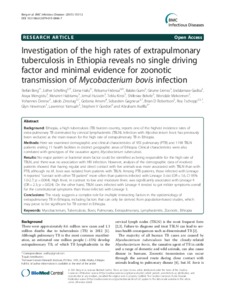Berg, Stefan and Schelling, Esther and Hailu, Elena and Firdessa, Rebuma and Gumi, Balako and Erenso, Girume and Gadisa, Endalamaw and Mengistu, Araya and Habtamu, Meseret and Hussein, Jemal and Kiros, Teklu and Bekele, Shiferaw and Mekonnen, Wondale and Derese, Yohannes and Zinsstag, Jakob and Ameni, Gobena and Gagneux, Sebastien and Robertson, Brian D. and Tschopp, Rea and Hewinson, Glyn and Yamuah, Lawrence and Gordon, Stephen V. and Aseffa, Abraham.
(2015)
Investigation of the high rates of extrapulmonary tuberculosis in Ethiopia reveals no single driving factor and minimal evidence for zoonotic transmission of Mycobacterium bovis infection.
BMC infectious diseases, Vol. 15 , 112.
![[img]](https://edoc.unibas.ch/style/images/fileicons/application_pdf.png)  Preview |
|
PDF
- Published Version
Available under License CC BY (Attribution).
574Kb |
Official URL: http://edoc.unibas.ch/dok/A6381838
Downloads: Statistics Overview
Abstract
Ethiopia, a high tuberculosis (TB) burden country, reports one of the highest incidence rates of extra-pulmonary TB dominated by cervical lymphadenitis (TBLN). Infection with Mycobacterium bovis has previously been excluded as the main reason for the high rate of extrapulmonary TB in Ethiopia.; Here we examined demographic and clinical characteristics of 953 pulmonary (PTB) and 1198 TBLN patients visiting 11 health facilities in distinct geographic areas of Ethiopia. Clinical characteristics were also correlated with genotypes of the causative agent, Mycobacterium tuberculosis.; No major patient or bacterial strain factor could be identified as being responsible for the high rate of TBLN, and there was no association with HIV infection. However, analysis of the demographic data of involved patients showed that having regular and direct contact with live animals was more associated with TBLN than with PTB, although no M. bovis was isolated from patients with TBLN. Among PTB patients, those infected with Lineage 4 reported "contact with other TB patient" more often than patients infected with Lineage 3 did (OR = 1.6, CI 95% 1.0-2.7; p = 0.064). High fever, in contrast to low and moderate fever, was significantly associated with Lineage 4 (OR = 2.3; p = 0.024). On the other hand, TBLN cases infected with Lineage 4 tended to get milder symptoms overall for the constitutional symptoms than those infected with Lineage 3.; The study suggests a complex role for multiple interacting factors in the epidemiology of extrapulmonary TB in Ethiopia, including factors that can only be derived from population-based studies, which may prove to be significant for TB control in Ethiopia.
| Faculties and Departments: | 09 Associated Institutions > Swiss Tropical and Public Health Institute (Swiss TPH)
09 Associated Institutions > Swiss Tropical and Public Health Institute (Swiss TPH) > Department of Epidemiology and Public Health (EPH) > Human and Animal Health > One Health (Zinsstag) |
|---|
| UniBasel Contributors: | Schelling, Esther and Zinsstag, Jakob Z and Tschopp, Rea |
|---|
| Item Type: | Article, refereed |
|---|
| Article Subtype: | Research Article |
|---|
| Publisher: | BioMed Central |
|---|
| ISSN: | 1471-2334 |
|---|
| Note: | Publication type according to Uni Basel Research Database: Journal article |
|---|
| Language: | English |
|---|
| Related URLs: | |
|---|
| Identification Number: | |
|---|
| edoc DOI: | |
|---|
| Last Modified: | 31 Dec 2015 10:57 |
|---|
| Deposited On: | 05 Jun 2015 08:52 |
|---|
Repository Staff Only: item control page


